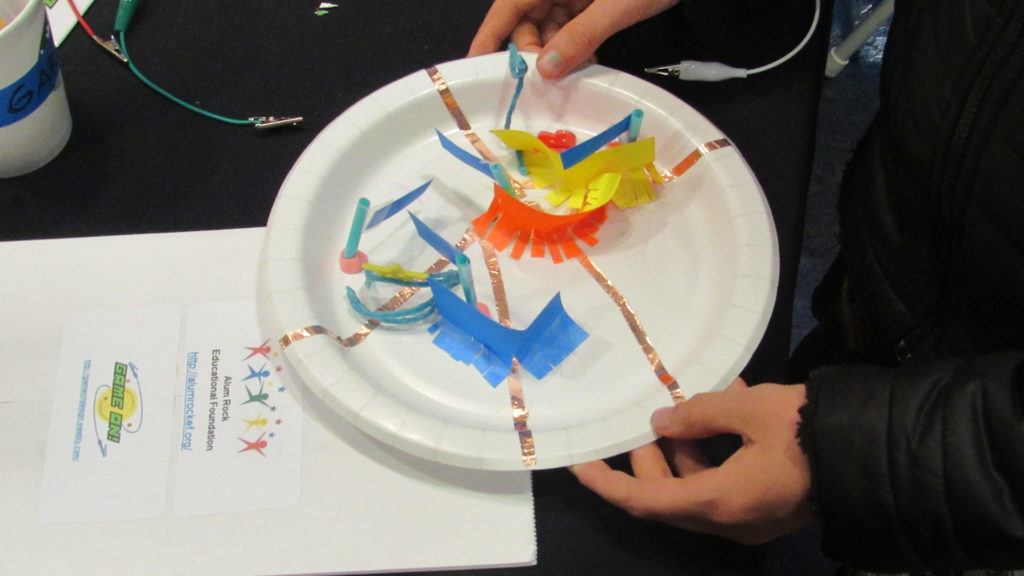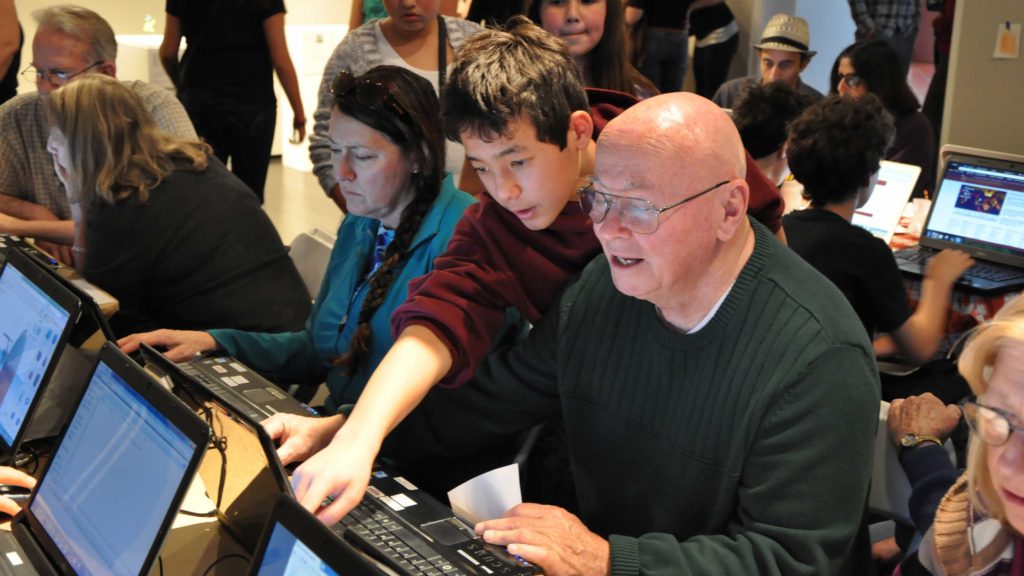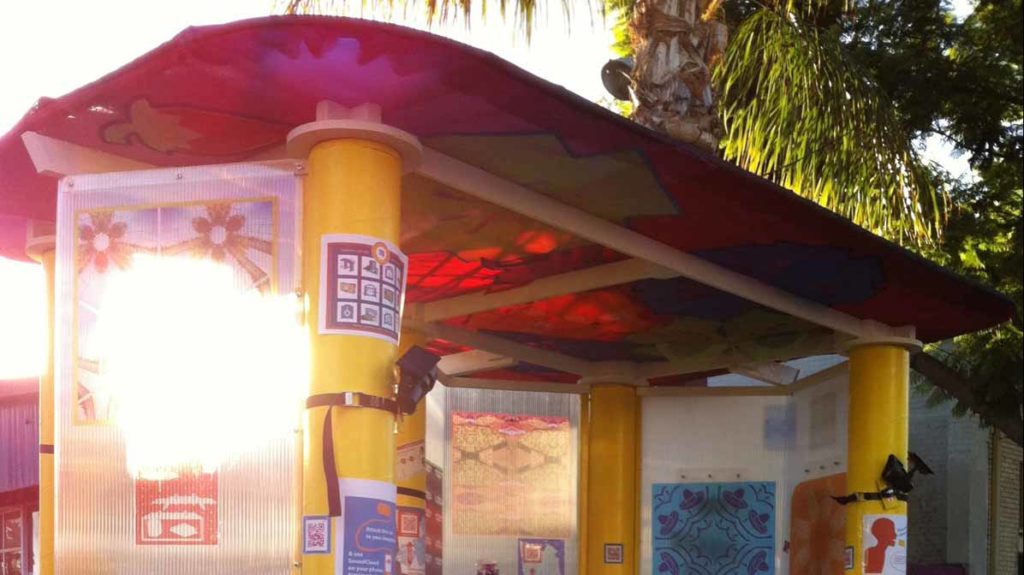Okada Design

Corinne Okada Takara
Corinne is a Bay Area artist and arts education specialist. Her technology infused youth art projects in Alum Rock have received state and national recognition. She has engaged Alum Rock youth in collaborative art projects since 2006. Corinne creates narratives exploring the intersection of cultures in her collaborative community projects. She majored in Design at Stanford University and received the Guilla MacFarland Award in Design upon graduation.
She has been recognized by the City of Cupertino with The Distinguished Artist Award and in 2010 was honored as a KCI Merit Scholar by the Krause Center for Innovation. Her education workshops in Alum Rock have led to state and international awards for student animation projects, as well as to student exhibits at the San Jose Museum of Quilts & Textiles and at Montalvo Arts Center. She has designed and participated in numerous grant projects.
Collaborations with Okada Design

Uchiwa Light Up Fans
These workshops invite San José youth and adults to create their own interpretations of traditional Japanese festival dance fans with a bit of circuitry embedded. In a series of five workshops in the San José communities of Japantown and East San José, participants will explore both their own visual vocabularies and that of Japanese culture as they design their own LED light-up Uchiwa fans. Using laser cut fan frames, copper tape, LED light circuit stickers and coin cell batteries, youth and adults will create fans that celebrate the rich blending of cultures in San José. Youth workshops will be held at the AYA Makerspace on the Mathson/Renaissance Middle school campus and the Hillview Library in East San José, and Burnett Middle School near Japantown, San José. There will be a public workshop at the Japantown Immersive event on May 12, 2018, and youth will be encouraged to attend the event with their families and dance with their fans while there. More info will be posted as it is available.

Game On!: Game Controllers & Paper Plate Pachinko
A playful pop-up workshop exploring game design using both physical materials and digital tools. Participants created musical mazes using a conductive marble that rolls along and completes open circuit connections on a paper plate and game controllers using recycled materials connected to a computer through the technology tool MakeyMakey. This workshop builds community through art/circuitry explorations in this public makerspace at the Paseo Public Prototyping Festival 2017 in Downtown San José.

Dia del los Muertos Calaveras 3D Workshop
A 3D Exploration engaging middle school and high school students in learning 3D CAD designing tools to bring their artistic and design ideas to life. Teens reflected on the cultural holiday, Dia de los Muertos for this workshop. They used Tinkercad to design and create 3D calaveras (skulls) honor someone close to them. The 3D designs were printed using glow-in-the-dark filament and were installed at the library from October 16th -November 13th, 2014. Each design included a statement from the artist about who they were honoring. After the installation, the teens took their creations home.
The workshops were held at the Dr. Roberto Cruz-Alum Rock Library in East San José and financially supported by AREF and The Friends of the Alum Rock Library.

You Are Here Street Banner Project
5th grade students in San José and Hawaii created textile designs reflecting on their local community. Students used VoiceThread to discuss and explore each other’s pattern designs and created digital textile designs and Japanese furoshiki wrapping cloths. With an expanded understanding of visual vocabulary, the San José students photographed their neighborhood using single use cameras.
They collaboratively created street banners using digital patterns created from the photos, as well as the photos themselves. Students presented their designs to the local Business Association and to the San José Office of Cultural Affairs for approval and installation. Students also taught components of the workshop to the public at the Montalvo Art Center’s Art Splash.
The project was honored as one of the Nation’s Top 100 Innovative Education Projects at the 2011 Microsoft National Innovation Education Forum. AREF supported the project through a grant and as the Fiscal Agent for additional grant funds.
Banners are currently hanging in the Alum Rock Village at the corner of Alum Rock Ave and White Road. Banners are also on display in the Internet Café at the Dr. Roberto Cruz – Alum Rock Library and the Alum Rock Union Elementary School District Office.
Picking Strawberries on Gold Mountain
This animation workshop series integrated social studies, art and technology. 4th and 5th graders at Cureton Elementary School in Alum Rock created collaborative videos about the history of Heinlenville (one of San José’s Chinatowns), which was buried under a municipal bus yard for decades. Students sketched and studied real artifacts from an archeological dig and distilled their knowledge into three animations, with a Chinese immersion school in Cupertino providing the music for the video.
Final videos are in the Next Vista for Learning Video Library. The video won the Excellence in Media Production: 4th/5th – Animation at the 2010 International Student Media Festival. The project was also honored as the winner of the 2010 Rambus/KCI Innovation Award and was supported by an AREF grant.
This project was also honored as the winner of the 2010 Rambus/KCI Innovation Award. This project was supported by an AREF grant.

Thinking Outside the Box - Stop Motion Animation
4th and 5th grader students at Cuerton Elementary School in San José created a collaborative animation that represented their ideas on “thinking outside the box”. Students worked in teams to create clay parts, film and narrate their sequences using the free tool Audacity. The narration component was great for ESL students, as they could keep recording their voice until they were happy with what they said. Students explored importing and organizing still images in the free animation tool Monkey Jamand final editing was done in Premiere Elements. The final video won first place at the 44th Annual California Student Media Festival in the Elementary School Fine Arts category.
There is only one winner in each category for the entire state of California! The video also won the Judges Favorite Award at the 2009 International Student Media Festival and was honored as a runner up for the 2009 Rambus/KCI Innovation Award. This project was supported by an AREF grant.
This project was also honored as the winner of the 2010 Rambus/KCI Innovation Award. This project was supported by an AREF grant.
Other Okada Design Projects Engaging Alum Rock Students in Collaborative Art, Design and Technology Projects:
A Serving of Shapes: An Exploration in 3D Printing
This workshop engaged teens at the Dr. Roberto Cruz/Alum Rock Library and the Mayfair Community Center in exploring 3D printing using the software tools Tinkercad and SketchUp. Participants’ designs reflected on local agriculture history and their personal relationships with food. Their 3D designs were printed on an Afinia 3D printer for installations at both locations.
Their sculptures were also integrated into an exhibition at the de Saisset Museum at Santa Clara University. The workshops were made possible through the support of the de Saisset Museum, an Applied Materials Excellence in the Arts Grant, and the San José Museum of Art’s Around the Table Initiative.

Special Spots
A youth project engaging high schools, middle schools and elementary schools in developing art concepts to inform the real design of 8 bus stop shelters in San José. 6th grade students at Renaissance Academy at Mathson and 5th grade students at Goss Elementary School participated by mapping their personal transit paths through their communities, creating automata which integrated their mapping data and their written thoughts and reflections on special places in their community. The Santa Clara Valley Transit Authority and San José Office of Cultural Affairs funded this project, and the final bus stop shelters were designed by Merge Conceptual Designs in L.A.
Patterns for Freeway Bike and Pedestrian Overpass
6th grade students at Renaissance Academy at Fisher documented their neighborhoods using single use cameras and explored radial pattern design on paper. They used the software program, Repper Pro to create design patterns from their photos. Selected designs were incorporated into concrete and laser cut steel patterns on the Highway 101/Tully Road overpass. The project was supported by the Santa Clara Valley Transit Authority and the San José Office of Cultural Affairs. In November 2013, concrete line formers were poured at the HWY 101/Tully Road overpass.
The Ribbon Cutting Celebration for the Pedestrian Overpass Public Art is on May 30, 2014. In addition to the pilasters above, entry pilasters have also been added on both sides of the overpass.
In September 2014, the San José City Council honored the students whose designs were used on the line formers and pilasters with a Commendation for their efforts.
Seeking Shelter Design Challenge
This multi-school/multi-state project engaged youth in envisioning innovative bus stop shelters which address community and environmental needs. Students in California (4th, 5th & 6th grade students from Alum Rock School District and 5th grade students from Cupertino), Hawaii (4th grade), Pennsylvania (4th grade), and Utah (4th/5th combo) participated.
Student created cardboard prototype designs and SketchUp 3D rendered models were judged by an international panel of architects, designers and public transit authority engineers. Elementary through high school students participated, with the participation of a school in Azerbaijan (4th grade) turning the project into an international one. Students from California also taught the public components of the workshops at a street festival. The project was supported by the Zero1 Art & Technology Biennial.













